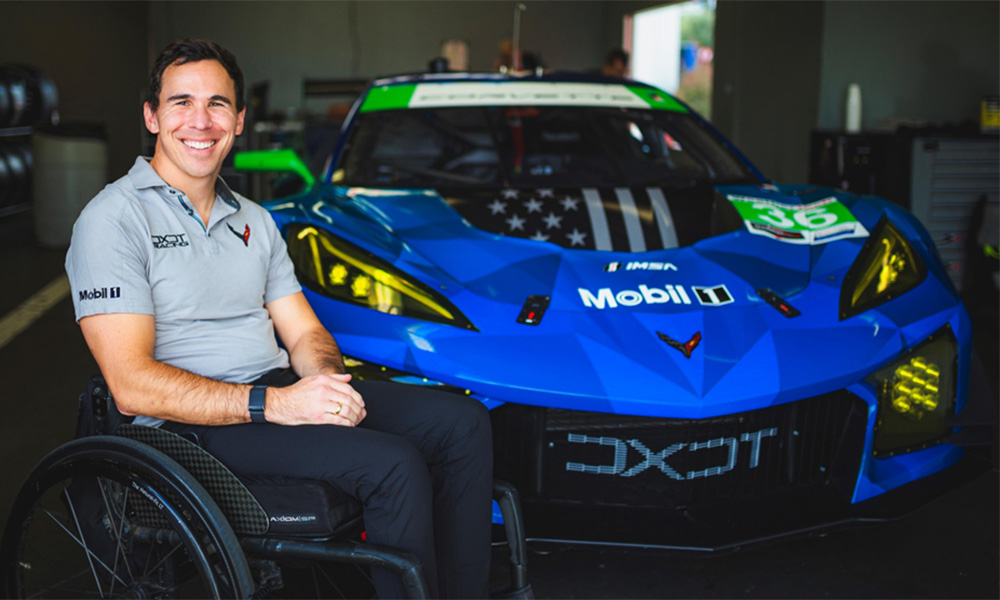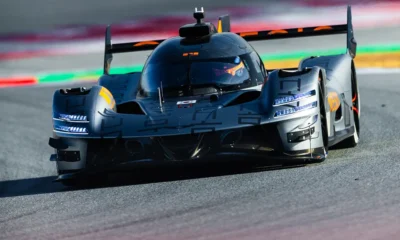
Photo: Brian Simpson/Stillhouse
Robert Wickens said the “stars aligned” for him to make the move up to the IMSA WeatherTech SportsCar Championship with DXDT Racing next year after several years of searching for a ride in the top series.
The 35-year-old Canadian will contest the five sprint races with a to-be-announced co-driver in the team’s No. 36 Chevrolet Corvette Z06 GT3.R as part of the next step in his racing journey after sustaining injuries in a NTT IndyCar Series race at Pocono in 2018 that left him paralyzed from the waist-down.
Wickens, who won the 2023 Michelin Pilot Challenge TCR title with Bryan Herta Autosport, shared some of the struggles of finding a ride in the top series with reporters during an IMSA-hosted media session on Monday.
“I was actively trying to find an entryway into the IMSA WeatherTech series, and then at the same time, DXDT was trying to find a way in,” he said.
“It was one of those things where we were introduced to each other. We found a way to make it happen.
“It’s not easy to find a drive in the IMSA WeatherTech series. The driver lineups across every category are so strong.
“I was just at the right place at the right time. The stars aligned.
“I can’t thank DXDT enough for the opportunity [and] Bosch for frankly making it all possible. I’ve been wanting to move up into WeatherTech for quite some time.
“I felt like I was fairly transparent in that messaging, but it was always difficult communication trying to convince the OEMs or the the team owners to: one put me in the car like in other racing driver and then say, ‘Oh by the way, you have to design a whole braking system that doesn’t exist.’
“So the fact that Bosch came to the table with with their technology, it’s given me the opportunities that that I want my career.”
Wickens debuted the new Bosch-developed braking system in the final two rounds of this year’s Pilot Challenge season in his BHA Hyundai Elantra N TCR car.
He explained that the system will be slightly different in the Corvette as it will utilize a full brake-by-wire setup.
“We’re still in the design and development phase with the help of Pratt Miller,” said Wickens.
“As you can imagine, there’s a lot of moving pieces. The Bosch electronic braking system is relatively plug-and-play.
“The system is the same; the EBS modules are the same that we were using in the TCR car. But then adapting it into a different car, there’s always a level of adjustment.
“The function we’re going to be running, will be slightly different again to what we were running in TCR, so we’re going to be doing a full brake-by-wire system.
“With the help of General Motors, Pratt Miller and Bosch, all three working in unity, it’s going to take some time.”
Wickens said he’s aiming to get time in GM’s driver-in-the-l0op simulator in the “coming weeks” with the first straight-line testing with the system targeted for January and on-track performance testing scheduled for late February or early March, ahead of the first sprint race of the season at Long Beach on April 12.
“We’re definitely up against the clock a little bit, but I know if anyone’s going to do it, it’s GM, Bosch and Pratt Miller,” he said. “I know I’m in good hands and I’m just excited.”
A 3D-printed rapid production version of the steering wheel with the hand controls have already been created by Pratt Miller, with Wickens having provided his initial input following a recent visit to the Michigan-based organization.
“It’s tailor-made, really in the end,” he said. “It’s a unique situation. Not many drivers can tailor-make their throttle and brake and everything to how they want, unless you’re driving in Formula 1 or something.
“It’s been a cool journey so far.”
Wickens said the full brake-by-wire setup will pave the way for the system to be applied to other categories of cars, such as LMDh machinery and open-wheel cars in the future.
“We’ve kind of bit the bullet and are plugging away on a full brake-by-wire system here,” he said.
“I don’t want to even begin to explain how it works because frankly I’m still trying to understand it myself. But thankfully there’s some smart people behind me that know what they’re doing.”
He revealed the system will have its own homologation attached specifically to DXDT’s chassis number that will be for his use exclusively, at least initially.
“Even though my car will have that braking system, you couldn’t just put that into another Corvette GT3 just like that,” said Wickens.
“I believe that’s how it works. It’s not like because I have it, anyone can have it.
“But once the FIA and IMSA all agree that it’s safe, reliable and there’s no performance advantage, it gets signed off on and we’re off to the races.”


























